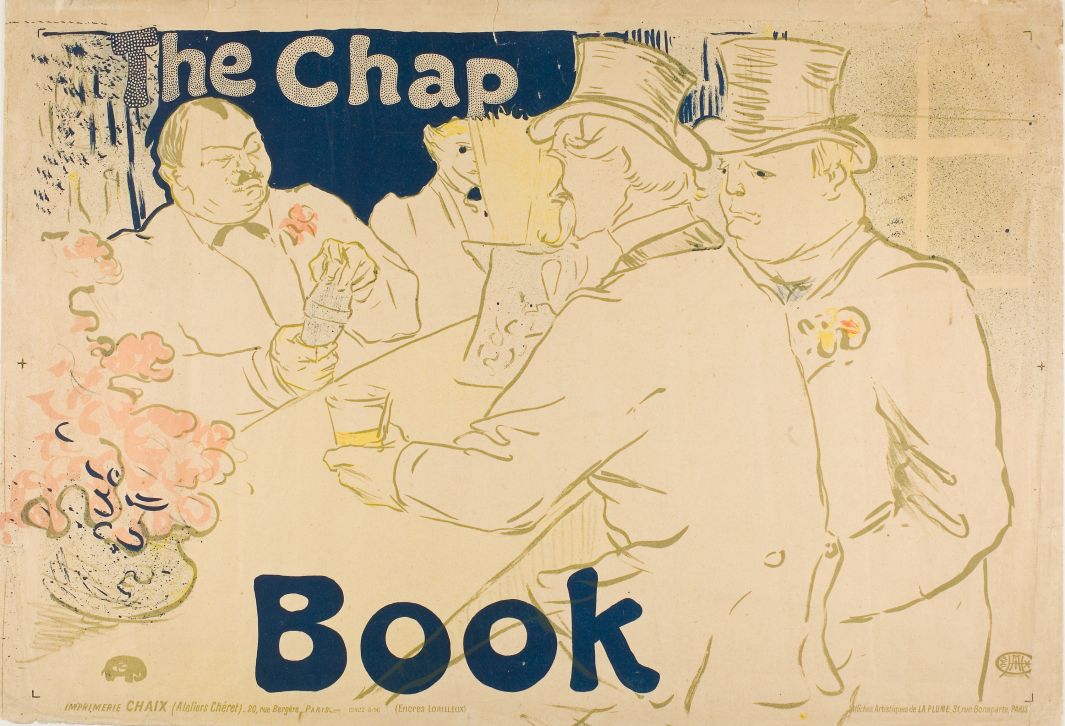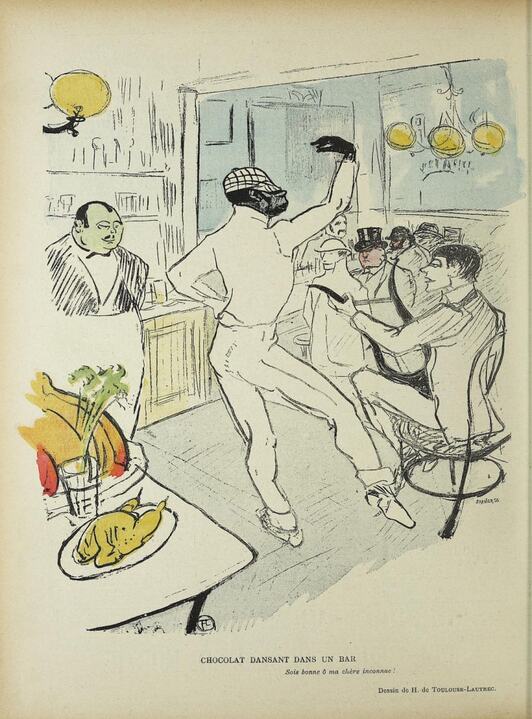|
Where? Room 10 of the San Diego Museum of Art (fourth drawer of the most-left cabinet)
When? 1895 Commissioned by: The magazine La Plume on behalf of The Chap-Book in Chicago What do you see? An advertisement poster for the American literary magazine The Chap-Book. The scene is the Irish and American Bar in Paris. An anonymous man with a large mustache sits at the bar with a drink. The iconic barman Ralph is preparing a drink for Tom, the driver of the horse-drawn carriage of the Rothschild family, who just arrived. The half-Chinese, half-American-Indian barman was born in San Francisco and known for his special cocktails. Both Ralph and Tom have a floral decoration on their jacket. In the background, another anonymous man stands behind the bar. The bottom of the poster lists, in small print, the printer (Imprimerie Chaix) and the magazine (La Plume) in which this poster is advertised. What is The Chap-Book? The Chap-Book was an American magazine published between 1894 and 1898. Every two weeks, an issue was published containing several short literary stories. An issue cost 5 cents in 1895 and contained, on average, about five short stories. Backstory: The Irish and American Bar was located at the Rue Royale in the center of Paris. The Rue Royale is a short street between the Place de la Concorde and the Place de la Madeleine. The owner of the bar was a Swiss man (Achille) and an Englishman (Reynolds) ran the bar. While Toulouse-Lautrec preferred to hang around in the artistic Montmartre neighborhood of Paris, the Irish and American Bar was among his favorite spots when he wanted to escape Montmartre. When visiting the bar, Toulouse-Lautrec would encounter many other artists. Other people frequenting this place where coachmen who were waiting while their employers would dine in one of the fancy nearby restaurants. Toulouse-Lautrec featured this bar in several posters and drawings, including Chocolat Dancing in the Achille Bar.
Other versions: As Toulouse-Lautrec created the original drawing for this poster on a stone tablet, it could be used to create many prints. Toulouse-Lautrec created two versions of this lithograph. The first version does not have the advertising text, and 100 hundred prints of this version were created for collectors. Some of these prints are now owned by museums like the Museum of Modern Art and the National Gallery of Art.
After the first version was printed on posters, Toulouse-Lautrec added the advertising text and the current poster was printed. Besides the San Diego Museum of Art, prints of this second version are owned by museums like the Art Institute of Chicago. Most museums do not have the lithographs of Toulouse-Lautrec on permanent display as they are sensitive to light exposure. What is Lithography? An image is painted on a smooth metal or stone surface. This surface can subsequently be used to print multiple copies of the original image. Lithographic posters became popular during the end of the 19th century. The recent advances in color printing made it possible to print colored lithographs relatively cheaply. Toulouse-Lautrec was among the artists that picked up lithography. He was able to make good money with these lithographs as the laws on public marketing were relaxed and bars, night clubs, and theaters were now allowed to publicly advertise their business. Who is Toulouse-Lautrec? Henri Marie Raymond de Toulouse-Lautrec-Monfa (1864-1901) came from a French aristocratic family. He suffered from health problems throughout his life and only became 1.42 m (4 ft 8 in) tall. Despite his aristocratic roots, he enjoyed a Bohemian lifestyle in Paris. Even though Toulouse-Lautrec could count on the financial support of his family, he earned his own money as a painter, draughtsman, and illustrator. He was one of the first artists who successfully jumped on the opportunity to create advertising posters. His artistic style was inspired by artists like Degas and Manet. A representative example of his paintings is At the Moulin Rouge: The Dance in the Philadelphia Museum of Art, which he painted in 1890.
Fun fact: Henri de Toulouse-Lautrec loved to spend time in the bar. The Irish and American Bar in this painting was his favorite for some years. He spent so much time there that he invited people that wanted to meet him to the bar. He was typically the last person to leave the bar in the night. He also helped to serve the clients of the bar occasionally. As Toulouse-Lautrec was very short, the owner of the bar had a special platform installed for him such that he could properly serve the clients.
Interested in a copy for yourself? Poster
Written by Eelco Kappe
References:
0 Comments
Leave a Reply. |
Categories
All
|
- Home
- Blog
-
Museums
- Alte Pinakothek
- Art Institute of Chicago
- Baltimore Museum of Art
- Barber Institute of Fine Arts
- Bargello
- Barnes Foundation
- British Museum
- Church of Sant’Anastasia
- Cleveland Museum of Art
- Courtauld Institute of Art
- Detroit Institute of Arts
- Frans Hals Museum
- Galleria Borghese
- Gallerie dell'Accademia
- Getty Museum
- Guggenheim
- Hermitage Museum
- Kunsthistorisches Museum
- Kunstmuseum Basel
- Legion of Honor Museum
- Louvre
- Mauritshuis
- Metropolitan Museum of Art
- Musee d’Orsay
- Museum of Fine Arts in Boston
- Museum of Modern Art
- National Gallery in London
- National Gallery of Art
- National Museum in Poznań
- Norton Simon Museum
- Ny Carlsberg Glyptotek
- Palace of Versailles
- Palazzo Pitti
- Palazzo Vecchio
- Petit Palais
- Philadelphia Museum of Art
- Prado
- Pushkin Museum
- Ravenna Art Museum
- Rijksmuseum
- San Diego Museum of Art
- Santa Maria delle Grazie
- St. Peter's Basilica
- Städel Museum
- Statens Museum for Kunst
- Tate Britain
- Tate Modern
- Timken Museum of Art
- Uffizi
- Vatican Museums
- Wallace Collection
-
Artists
- Altdorfer
- Anguissola
- Berlin Painter
- Bosch
- Botticelli
- Boucher
- Bronzino
- Bruegel the Elder
- Brunelleschi
- Cabanel
- Caillebotte
- Canova
- Caravaggio
- Carpeaux
- Cezanne
- Cimabue
- David
- Degas
- Delacroix
- De Maria
- Donatello
- El Greco
- Fontana
- Fra Angelico
- Fragonard
- Gauguin
- Gentileschi
- Gericault
- Gonzalez-Torres
- Goya
- Hals
- Hogarth
- Hokusai
- Ingres
- Leonardo da Vinci
- Lippi, Filippo
- Longhi, Barbara
- Lorrain
- Makovsky
- Manet
- Massys
- Matisse
- Merian
- Michelangelo
- Mochi
- Modigliani
- Monet
- Panini
- Parmigianino
- Perugino
- Picasso
- Pisanello
- Raphael
- Rembrandt
- Renoir
- Reynolds
- Rivera
- Rodin
- Rubens
- Scultori
- Seurat
- Steen
- Tintoretto
- Titian
- Toulouse-Lautrec
- Turner
- Uccello
- Van der Weyden
- Van Dyck
- Van Eyck
- Van Gogh
- Van Hemessen
- Vasari
- Velazquez
- Vermeer
- Veronese
- Vigée Le Brun
-
Locations
- Books
- About Us



